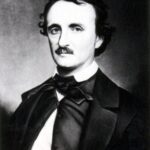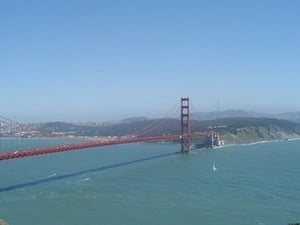In a majority of poems from the Romantic era there is a profusion of the use of supernatural and mythological references in reference to the content of the individual pieces. They would come in various states and mean different things, yet they would all serve the same purpose and that would be to help the reader understand and appreciate the sense of awe and creative genius that made this piece what it is. As Wordsworth said, “Poetry is the spontaneous overflow of powerful feelings,” and you would not find much more of an appreciated understanding of what is meant unless one reads the poetic geniuses of the likes of Samuel Taylor Coleridge.
In the poem “The Rime of the Ancient Mariner” S.T Coleridge shows clearly why he is still revered today as one of the best of all times. This piece is not only powerful with supernatural and mythological elements but has an aura of what is essential in all great work, emotional content. There is such an abundance of information that can readily be given that it is almost impossible to choose what to speak of.
This piece is essentially about crime and punishment. The crime is not just a meager one of a senseless killing, but rather one against nature of and the power of the Creator and it is the power of God that punishes this Mariner. One might think of it as unjust to be punished for killing an Albatross, yet, without the use of this bird, there would not be the richness of text that everyone who read it appreciates. The Albatross was more than just a bird that followed his ship. It was a guide sent by the Almighty, a sign of good luck, a protector of sorts and also a being that was more a part of the crew since it ate their food, was with them for vespers and was even spoken of with the phrase “As if it had a Christian soul,” (Rime of the Ancient mariner, Line 65).
For all the awesome qualities that were bestowed upon this Albatross to show how unique it was, it is actually the punishment of the Mariner that shows more of the supernatural powers at work. From the time of his senseless killing of the bird there is a punishment that falls upon him that could only be seen as supernatural. The wind that was driving their ship stopped blowing, no rain fell and he also had no sleep. It is from this text that these haunting words emerge; (line 119- 122)
Water, water, every where,
And all the boards did shrink;
Water, water, everywhere,
And not a drop to drink.
The punishment is so sever that he cannot see life anymore in anything around him, everything is dead. The men around him are seen as rotting corpses and he is on the brink of insanity if not already there so much so that he actually nit his arm to drink his own blood to slake his thirst.
One of most spectacular scene of this legendary piece comes when he sees a specter of a woman coming to him. The very essence of what she signifies is of nightmare proportions since she is called ‘Life in death.’ It shows a struggle that is happening between death and ‘Life in death’ playing for the prize of the ship and in the end it is the sickening specter of ‘life in death’ that conquers the ship. With everything happening around him, his punishment is that he remains alive to suffer while everything around him dies. Yet even in this state all is not lost since he sees things happening around him and knows that there are acts of redemption that can yet be attempted if he seeks forgiveness and it is granted upon him.
Yet, it is ironic that the things that grant him a renewal on life are snakes when according to Jewish and Christian scriptural texts it is seen as representations of evil. But in Hindu mythology it is a holy creature. Thus, Coleridge manages to show life in the unlikeliest of creatures to signify redemption.
In this piece of marvel there is not only the presence of retribution and forgiveness, but also agents of these tasks. There is reference to these spirits in ‘Part 6’ of the piece which is the conversation between two spirits. They speak of his penance and how he has suffered his punishment. These beings are shown as spirits of the Polar region who help to place the Mariner into a trance to drive his ship home and from their conversation and the things that they do, they can more easily be seen as ‘Furies.’ These mythological beings, the Erinnyes (also spelled Erinyes) were “the Angry Ones”, known as the Furies in Roman. They were the feared avenging goddesses in Greek and Roman mythology who were born from the falling drops of blood of Uranus (Sky) when he was mutilated by his son, the Titan Cronus. The drops fell on Mother Earth (Gaea) and impregnated her. As their influence spread, the Erinnyes became the personification of the concepts of vindictiveness and retribution represented the psychological torments associated with a guilty conscience. Eventually their influence extended to the hearing of complaints of insolence by the young toward the old; punishing disrespect of parents by their children; as well as lack of hospitality to guests by their hosts, a terrific breach of ancient etiquette. In short, if you messed up, the wicked fury of the Erinnyes was not far. There were many who incurred the wrath of the Furies, with catastrophic results and it seems more than likely that the unfortunate Mariner incurred their wrath by his murderous action.
The wonderful thing about this wonderful piece is that it does not stick only to one type of being but seeks to use all of the supernatural forces that are available for use. In lines 490-1 it says “A man of light, a seraph-man, / On every corse there stood,” shows the use of the scriptural hierarchy of angels. Within the cultural context of medieval Christianity, the term “seraph” generally referred to the highest “order” of angels. A seraph, thus, would be an angel whose “position” in the heavenly realm would be “closest” to God. Taking various biblical terms that might refer to angelic beings, there is the formalized notion of nine choirs (or ranks) of angels, with the seraphim constituting the highest rank. Thus it was that the Mariner was not only the object of attention for the Furies but also of the ranks of heaven. Yet the angels did not come to claim him but rather the souls of the dead that were on the ship.
Samuel Taylor Coleridge is not only remembered for the use of the supernatural and mythological in “The Rime of the Ancient Mariner,” but also in “Kubla Khan” which is a piece that others have tried to copy and learn from for years, yet the text stands unique among every branch of writing. Every sentence is loaded with the wonder of creation and the power of the supernatural which makes this poem something that only man can make in the dream state, which is where he actually got the inspiration from. His poems have the power to enchant the reader and grasp the attention so much so that there is nothing else to do but remain and become enthralled in this word that he creates.
That Coleridge would take it upon himself to travel within the supernatural world with his pen is once more reflective of his obsession to control the audience. Coleridge here divides the endeavor of creating poetry for Lyrical Ballads into two parts: poems on ordinary, everyday objects in nature and poems in which the actual “incidents and agents” expanded upon were supernatural.
Staying within the supernatural realm gives Coleridge firmer footing from which to claim the status of creator. Regardless of whatever new and unsuspected charms a poet is able to conjure out of “things of every day”, the fact remains that it all is ultimately dependent upon an external creator-nature. Since the basis of the poem is external, it allows for the possibility of the reader bypassing the poet and directly accessing the vision. To write about the supernatural, however, would eliminate any loopholes by which the audience might evade the poet. The supernatural is beyond nature, is outside nature, and such a case, whether the vision is given through revelation or created through the creative process, it conveys upon the poet a position of undeniable exclusive power. There is only one point of access, and it is entirely controlled by the person to whom that particular supernatural event was revealed. This sets up the relationship that Coleridge is ever obsessing about-that of the absolute dependency of an audience upon the poet. It is quite obvious that Coleridge uses this tension between the natural world and supernatural world, but his preference is for the supernatural world in which he is the indisputable lord.
In “Kubla Khan,” Kubla’s resides in Xanadu, a place of great natural beauty and of mystery which according to his decree as lord of this place a pleasure dome is built. The central element of an “underground scenery” is Alph which may refer to ‘alpha’ first letter of the Greek alphabet and seen as the beginning of life in Christianity. This river is immediately shown as sacred which in Latin is ‘sacer’ meaning ‘holy’ and also connected with a god of the underworld. The surroundings of the river perhaps suits the second meaning best since a considerable stretch of the river runs underground, through caverns of measureless, or supernatural proportions showing that the expanses which man is not able to “fathom” both in a literal and figurative sense. Its final destination is a place of extreme darkness and indefinite depth. A beginning such as the not only speaks of but reeks of supernatural qualities in this powerful piece. It also shows why people have been trying to copy its format and write in this manner since it was written.
A lucrative picture of the landscape is given showing the grounds that are reserved for the “project” and the entire area is confined by walls and towers.
On one peculiar green hill (line 13) a chasm runs downward through, or across, a thicket of cedar trees in a sloping direction. There are several things happening here and the arrangement of words show a mysterious on the place. The two words used in this section, ‘holy and enchanted’ (line 14), hint at mystical aspects and connection with religious or magic powers. The next comparison which uses the word ‘as’ (line 14-15) is an association with a haunted place, in this case with a place that is visited frequently by a woman, or a woman’s spirit, which grounds the scenery as a cursed place making it an ideal setting for a scene of forbidden longing love between humans and demonic powers. This is seen in line 16 which says, “By woman wailing for her demon lover,” which once again reinforces the use of the supernatural by both the character and the setting which is set beneath a waning moon.
With the help of very illustrative comparisons, a graphic description of an eruption is given. (line 17-19) a mighty fountain is forced out of the ground by supernatural forces at intervals. The gigantic and powerful ejection of water or, what seems as much plausible within the whole set of images, the eruption of magma, is seething with turmoil, displaying the visual and aural senses used when seeing liquid reaching its boiling point. We can compare this scene with other familiar phenomena which would serve to create a graphic picture in the reader’s mind. The rocks are compared to “rebounding hail” (l.21). Here is something which comes from the earth being compared to something coming to the earth and in this passage, both are done. In this destruction, Kubla perceives ancestral voices, which come from far, showing reference to an afterlife prophesying the coming of war seeming to signify the destruction of the pleasure-dome and loss of life.
By the repeating of contrasting images like that of the sunny pleasure-dome and the caves of ice the speaker gives his evaluation of the event depicted in the preceding lines, he sees it as ‘a miracle’ (l 35), an event of a super natural kind, and, at the same time, based upon a very peculiar kind of plan. The speaker recalls a vision (l 38) not restricted to visual impressions of ‘a damsel’ (l 37) from Abyssinia, but also again accesses our ears when he mentions that she sings of Mount Abora while playing a dulcimer. He says that if he could revive “her symphony and song” within him, he would rebuild the pleasure-dome out of music, and all who heard him would cry “Beware!” of “His flashing eyes, his floating hair!” The hearers would circle him thrice and close their eyes with “holy dread,” knowing that he had tasted honeydew, “and drunk the milk of Paradise.” The imagination of this scene would give him, or gain him, very intensive, profound pleasure which shows not only the emotional impact of the vision but also of the potential inspirational powers connected with this delight.
In addition to this reaction, the Coleridge demands the reader or listener to perform acts of great reverence or awe towards this figure which reminds of symbolic gestures performed during a religious or magic conjuration or incantation, is to ‘Weave’ (l. 50) a circle round him thrice. The second act is to close your eyes with holy dread, or awe towards this superhuman being. The physical figure is represented by the words flashing eyes and floating hair, which also happens to be representative of the ancient gods and finally, by the assumption that “He on honey-dew has fed/ And drunk the milk of Paradise,” (l. 53-4) has been entitled to share the privileges of gods like those in Olympus who eat ambrosia and drink nectar.
Coleridge was responsible for attempting to present the supernatural as real quite the contrary of his friend William Wordsworth who would try to render ordinary reality as remarkable, strange. “Kubla Khan” opens with an enigmatic but precise description of an emperor’s pleasure dome located in an enchanted, savage spot where a woman cries for her demon lover and the sacred river is flung up violently, then meanders before plunging through caverns into a sunless sea. In trying to interpret this symbolic site we can begin by seeing the dome as a human creation built in and over nature’s beauty and power. Then, in the last part of the poem the newly introduced “I” has a vision in which he is inspired by a singing woman; to imaginatively recreate in air the Khan’s dome. This poem is demonstrates a classic case of fantasizing about the exotic and luxurious East.
These two pieces of poetry have such a wide variety of images and supernatural as well as sacred elements that are involved that it not only captures the imaginations of those who read them but also seek to catch the attention of the reader to continue. Within “The Rime of the Ancient Mariner” and “Kubla Khan” both by Samuel Taylor Coleridge we see a representation of powers in the poems that are alive. These things not only attract people because of one style of mythology or religion but it fluctuates with setting and characters until there is a blend of creations that none can recreate. The power of these supernatural creations is that they remain as will the works of Samuel Taylor Coleridge.





